Astronomy Program News & Events
see also: McDonald Observatory press room / archive
2011
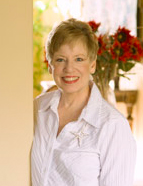
Sandy Wood
Day After Day, Her Voice Takes Listeners to the Stars
Texas Monthly
29 October 2011
San Antonio --On a clear, cool night in the early 1960s, a father drove his young, pajama-clad daughter to one of the T-head piers on Corpus Christi Bay to marvel at an object in the sky. The girl who peered up at the sky was Sandy Wood, and this year marked her 20th anniversary as the voice of the nationally syndicated radio program "StarDate." Speaking in her distinctive warm and soothing tone over synthesized tinkling chimes, Ms. Wood provides a daily two-minute peek into the world of astronomy, expounding on topics as varied as newly discovered quasars and the best place to watch a meteor shower.
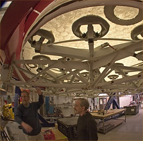
1st GMT Mirror from below
[Polakis]
The big interview: Wendy Freedman on the great telescope race
Houston Chronicle
23 October 2011
During the last decade, albeit quietly, there has begun a three-way race to build the next generation of optical telescopes. Three teams are competing to be the first to build a new ground-based observatory that will be much, much larger than any optical telescope built before. The competitors are: The Giant Magellan Telescope, the Thirty Meter Telescope and the European Extremely Large Telescope. The world's largest optical telescopes today are 10 meters. This new generation will have an effective mirror of at least 25 meters across. That's a huge difference. Whichever group gets finished first will discover a lot of new territory in physics and astronomy.

4th Frank N. Bash Symposium Invites Young Researchers to Advance Visions for the Future
5 October 2011
The 4th Biennial Frank N. Bash Symposium, "New Horizons in Astronomy," will bring together cutting edge researchers in astronomy and astrophysics for a two day symposium convening Monday, October 10, on the University of Texas at Austin campus. The meeting is designed to advance visions for the future of astronomy. Speakers, representing a dozen of the world's leading institutions, will address a wide range of topics, from the most inscrutable: Dark Matter and Dark Energy; to the Early Universe: Inflation, First Light, Black Holes and Galaxy Evolution; to leading edge engineering: HETDEX and the GMT; to the search for life: Extrasolar Planets, Disk Formation, and Solar System Chemistry. The meeting is made possible by the generosity of The Department of Astronomy and McDonald Observatory Board of Visitors.
Texas Cosmology Center's Dark Energy Video Wins Industry Awards
6 October 2011
Austin, Texas based Independent Media Productions has won two awards for "Dark Energy: Speeding Up the Universe," an educational video produced for the Texas Cosmology Center in collaboration with StarDate--a Videographer Award of Excellence and a Telly. The video is part of a series produced to explain complex theories of cosmology to a broad audience, and features interviews with prominent astronomers, images and animations. The Telly Awards is the premier award honoring outstanding local, regional, and cable TV commercials and programs, the finest video and film productions, and web commercials, videos and films.
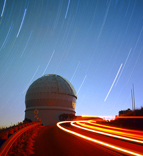
[Texas Explorer]
Penn State to Develop 'Habitable Zone Planet Finder' (HPF) Spectrograph for HET
Penn State Live
29 September 2011
University Park, PA --A new state-of-the-art instrument--a precision spectrograph for finding planets in habitable zones around cool, nearby stars--is being developed at Penn State with support from a new $3.3 million grant from the National Science Foundation. "This new Habitable Zone Planet Finder instrument will allow us to detect the existence of planets that are similar in mass to Earth and also are in orbits that allow liquid water to exist on their surfaces," said Suvrath Mahadevan, assistant professor of astronomy and astrophysics at Penn State and a co-principal investigator of the project.
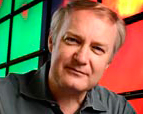
Volker Bromm [TACC]
Simulating the Universe for Movie Fans
Texas Advanced Computing Center Interview
28 September 2011
Q Can you tell us about the opportunity to work on Terence Malick's film, Tree of Life?
A It was a bit serendipitous. I had written a popular article about the early universe in Sky and Telescope, and Terry Malick read it and then got in touch with me. I think at that point he was still in the preparatory stages of putting the movie together, and then we met, and from there this involvement developed further.
Q It sounds like you worked closely with Terence Malick. Were there other people from the film that you worked with, and did they provide particular artistic direction for your part in the film?
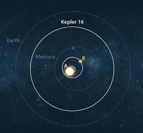
NASA
Scientists discover Tatooine-like planet
The Daily Texan
22 September 2011
Consisting primarily of sand and broken dreams, the fictional desert planet of Tatooine appears in five of George Lucas' six "Star Wars" films. In a research article published in Science Magazine on Sept. 16, astronomers working with the Kepler spacecraft revealed that the $600 million space observatory, launched in 2009 to find Earth-like planets orbiting other stars, had detected a planet that, like Tatooine, orbits two suns.
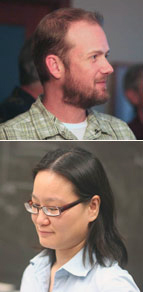
Erik Brugamyer & BiQing For
Erik Brugamyer Wins Livingston Fellowship, BiQing For Wins John Stocker Postdoctoral Fellowship from Australia
31 August 2011
Astronomy Graduate Student Erik Brugamyer has won a prestigious William S. Livingston Graduate Continuing Fellowship from the University of Texas at Austin Graduate School. The award recognizes a well-defined program of research, and major accomplishments since entering Graduate School. Erik is looking at the chemical compositions of stars that host planets. Are they different from stars that don't? BiQing For has won an inaugural John Stocker Postdoctoral Fellowship through the Australian Science and Industry Endowment Fund (SIEF). The fund supports scientific research using proceeds from wireless LAN licensing agreements. BiQing's project is The interaction of the Magellanic clouds with the Milky Way.
Freshman Research Initiative (FRI) 'Astronomy Stream' Students Conduct Independent Research
11 August 2011
Undergraduate freshmen have been conducting independent research designed for publication through the University's Freshman Research Initiative (FRI). One 'Astronomy Stream', supervised by Professor Don Winget and Research Scientist Mike Montgomery, conducts research on White Dwarfs, objects at the spectacular end of stellar life. A myriad of interesting physics can be explored with White Dwarfs, says Dr. Montgomery, such as the age of the Milky Way disk, and how dense, stellar plasma crystallizes. The leading edge program is a departure from having science students repeat classical experiments, and has proven to be an accelerant to more advanced levels of independent research. 25% percent of the College of Natural Sciences freshman class now participates.
Astronomy participants have helped to discover the first planet orbiting a binary star. "When you expect a lot of students, that's when you get a lot back," says Dr. Montgomery. A second 'Astronomy Stream', "Cosmic Dawn," employs one of the world's largest supercomputers, to create cosmological simulations of the early universe. The research, supervised by Professor Paul Shapiro, recreates the formation of the first galaxies, in filamentary structures spanning unimaginable distance.
HET Tracker Upgrade [Rafal]
UT Experiment Grapples With Essence of Gravity
The Texas Tribune
20 June 2011
We have all experienced gravity, but even to the brightest minds in science, it remains largely a mystery. Gary J. Hill, an astronomer at the University of Texas at Austin, is trying to change that. "We don't know why there's gravity," said Hill, one of the lead astronomers on the Hobby-Eberly Telescope Dark Energy Experiment, or HETDEX, which could turn gravity's time-honored laws on their head. "We have a pretty good theory of it. It may be that our observations could have a bearing on finally formulating why gravity exists." Hill has teamed with Karl Gebhardt, an astronomy professor at UT, on the $36 million project, which has prevailed despite the threat of natural disasters, potential lack of financing and all the kinks that can throw off a long-term project. The experiment's goal is to analyze our understanding of how the universe is expanding -- with ramifications on gravity, the Big Bang theory and the fate of the universe.
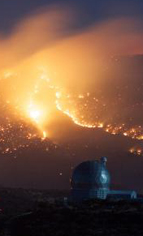
Cianciolo/McDonald Observatory
McDonald Observatory Gets Wild View of Texas Wildfires
Our Amazing Planet
19 April 2011
A week after the Texas wildfires cut power to the McDonald Observatory, the worst appears to be over, according to Anita Cochran, the associate director of the observatory. Observations have resumed and the astronomy center is scheduled to open to the public tomorrow (April 20), after surviving a close call with menacing wildfires. At the observatory, located in West Texas, wildfire weather conditions have been among the worst in the state's history. Dry grass and dry air, along with hot temperatures and howling winds, are fueling the sprawling wildfires that have scorched a million acres across the state, according to the Texas Forest Service. Things were heating up at McDonald this weekend, so the Texas Forest Service ran controlled burns on Sunday to get rid of all the fuel on the nearby mountains. "They were pretty scary looking, but were actually a good thing," Cochran told OurAmazingPlanet. "The observatory looks to be pretty safe right now."
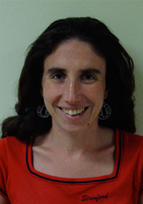
Asst. Prof. Jenny Greene
Public Lecture: Black Holes - Tiny But Powerful
Supermassive black holes, with masses of millions to billions of times that of our own Sun, are found lurking at the centers of most nearby large galaxies. The public is invited to the Bob Bullock Texas History Museum Monday, April 11, at 8 PM, for a lecture by Assistant Professor Jenny Greene, titled "Black Holes-Tiny But Powerful." Dr. Greene will discuss our search for the smallest supermassive black holes, and what they teach about the first black holes in the early Universe. The public lecture is hosted by the American Astronomical Society's (AAS) 42nd Annual Meeting of the Division on Dynamical Astronomy, convening in Austin the week of April 10-14.
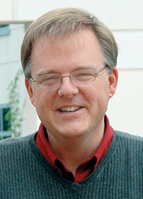
Prof. Lars Bildsten
Public Lecture: Exploding Stars!
Prof. Lars Bildsten, Tinsley Visiting Professor from The University of California, Santa Barbara, Kavli Institute for Theoretical Physics & Department of Physics, will present the public lecture Exploding Stars!, Thursday, March 24 at 7:00 PM, in RLM 4.102. [map]. Prof. Bildsten will discuss new modes of supernovae, recently discovered because we have new capabilities to scan the sky. Stars explode in the Universe once every second. We can now see 10 per day, or one hundredth of one percent. This has introduced new varieties of exploding stars and ways of looking at them. The public is encouraged to attend.
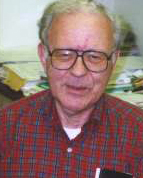
Dr. Robert Kraft
2010-2011 Antoinette de Vaucouleurs Lectureship and Medal Honors
The fifteenth award of the Antoinette de Vaucouleurs Memorial Lectureship and Medal honors the distinguished American astronomer and astrophysicist Dr Robert P. Kraft for a lifetime of achievement in astronomy. Dr. Kraft is responsible for much of what we know about the metal-poor populations of the Milky Way, both globular clusters and halo field stars, and has been a major figure in establishing observational constraints on the chemical evolution of galaxies. He is currently Professor Emeritus of Astronomy and Astrophysics at the University of California, Santa Cruz, and Astronomer Emeritus at the University of California Observatories/Lick Observatory.
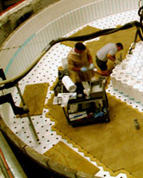
Building the first 8.4m mirror
Texas Science
It's been more than eight decades since Paris, Texas banker William J. McDonald left most of his estate to the unsuspecting University of Texas at Austin. McDonald wanted his money used to establish an astronomical observatory. The surprised university had no astronomy department or faculty at the time. After settling a legal struggle with McDonald's disgruntled family heirs, the university forged a unique partnership with an established astronomical power to the north -- the University of Chicago. The two universities built McDonald Observatory and never looked back. Decades later, the observatory became the sole property of the University of Texas. Since the late 1960s, through the observatory and its newly formed astronomy faculty in Austin, the university has developed one of the top 10 astronomy programs in the country. It is also one of the largest.
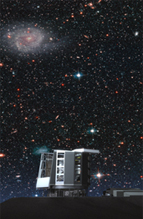
Giant Magellan Telescope
Public Lecture: Exploring Newly Discovered Worlds with the Giant Magellan Telescope
Prof. Dan Jaffe will present the public lecture Exploring Newly Discovered Worlds with the Giant Magellan Telescope, Saturday, February 12, at 1:00 PM, in the Avaya Auditorium ACE(S) 2.302 [map]. Prof. Jaffe will discuss humankind's landmark discovery in recent years of hundreds of extrasolar planetary systems, and the new generation of ground-based telescopes that will allow us to better understand them. Prof. Jaffe's research includes development of state-of-the-art instrumentation for infrared and submillimeter spectroscopy. He recently served as Chair of the Giant Magellan Telescope Science Advisory Committee. The Great Lectures in Astronomy public series is sponsored by the The University of Texas at Austin McDonald Observatory and Department of Astronomy Board of Visitors.


